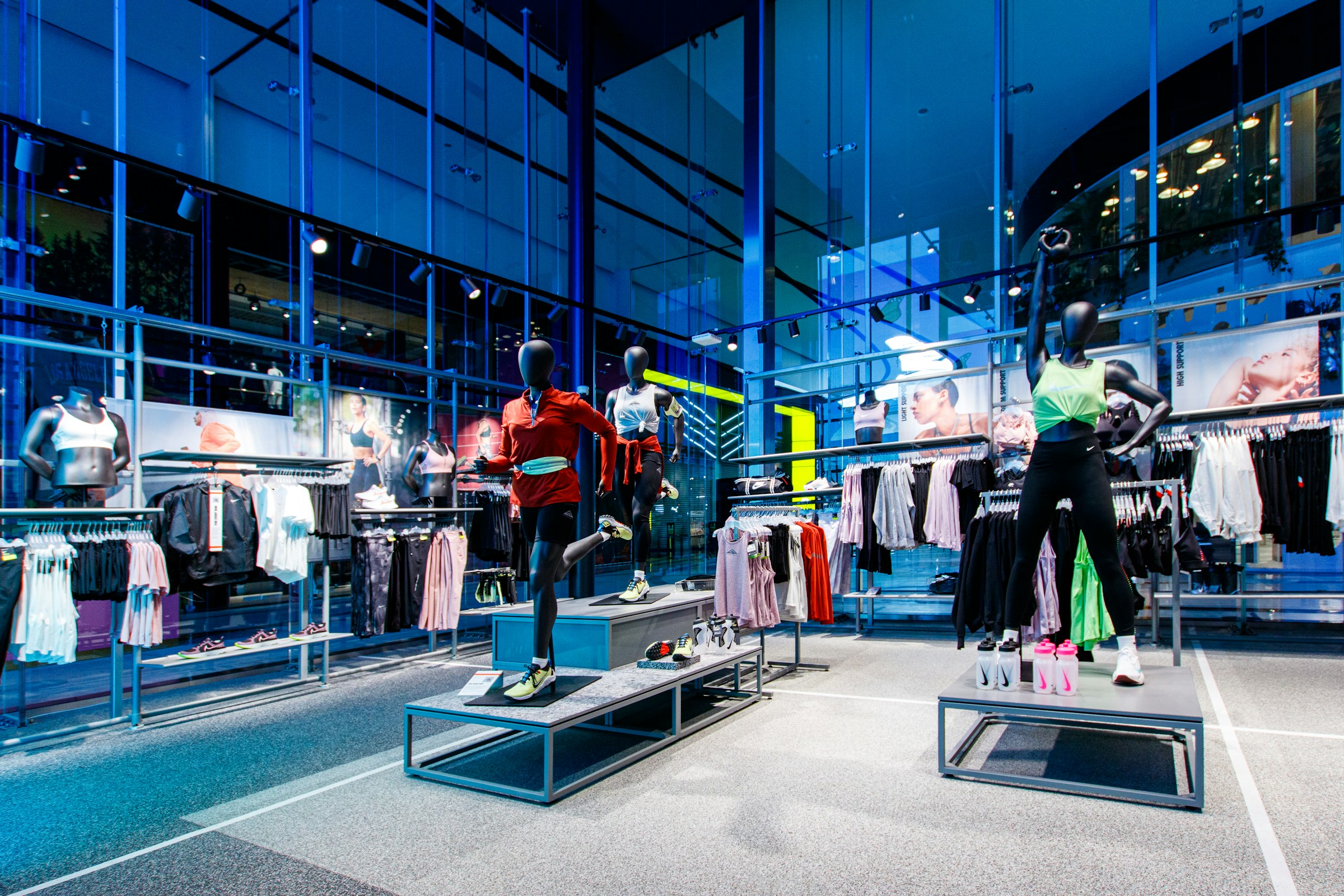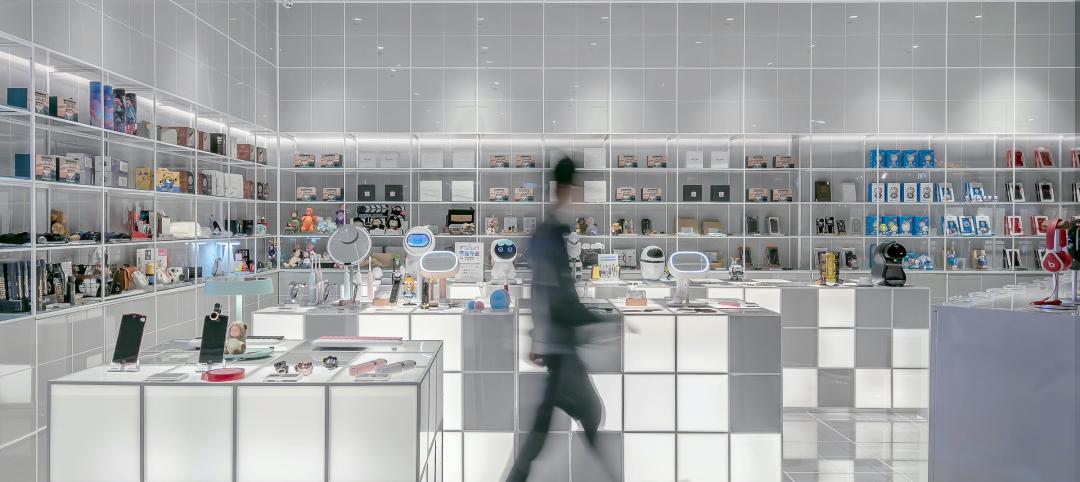Consumers are making lifestyle choices with wellness in mind, which ignites in them a feeling of purpose and a sense of motivation.
That’s the conclusion that the architecture and design firm MG2 draws from a survey of 1,182 U.S. adult consumers the firm conducted last December about their seeking healthier shopping experiences. (Download the full report.)
Nearly half of the respondents said they were aware of the effects that displays which communicate “wellness” have on their minds and bodies. About three in five respondents agreed that sounds generated by physical events—like waves or rain—coupled with natural light can establish a sense of calm. And about the same ratio preferred shopping environments with activity spaces, such as meditation or exercise rooms.
MG2’s report delineates the survey’s respondents by age, location (i.e., suburban, urban, or rural), gender, and household income. The report also groups the respondents into three categories:
- Pathfinders, who like to find, learn about, or develop wellness practices that will fit their lifestyles. Pathfinders accounted for 42% of respondents;
- Escapists, who look for relaxing or centering wellness outlets. This group represented 35% of respondents; and
- Ritualistics, who are committed to wellness routines that address their mental well-being on a scheduled basis.
For many, wellness in retail design equates to calm
The survey elicited responses that accentuated the range of meaning that “wellness” now encompasses. For example, 54% identified physical exercise, like running or yoga, as a wellness practice that enhances mindfulness. When it comes to enhancing emotional wellness, 48% of the survey’s respondents cited personal spaces for meditation or relaxation.
Indeed, “healing,” “tranquility,” and “re-energizing” were the top three themes cited for brands to emphasize in a consumer-focused wellness experience.
When taking a wellness-driven journey, Pathfinders prefer predetermined routes, as do consumers within the 27-43 and 43-49 age groups, whereas Escapists want to determine their own paths. (Ritualistics split down the middle.) All but the Baby Boomer cohort prefer visual messaging cues that help them navigate a wellness journey.

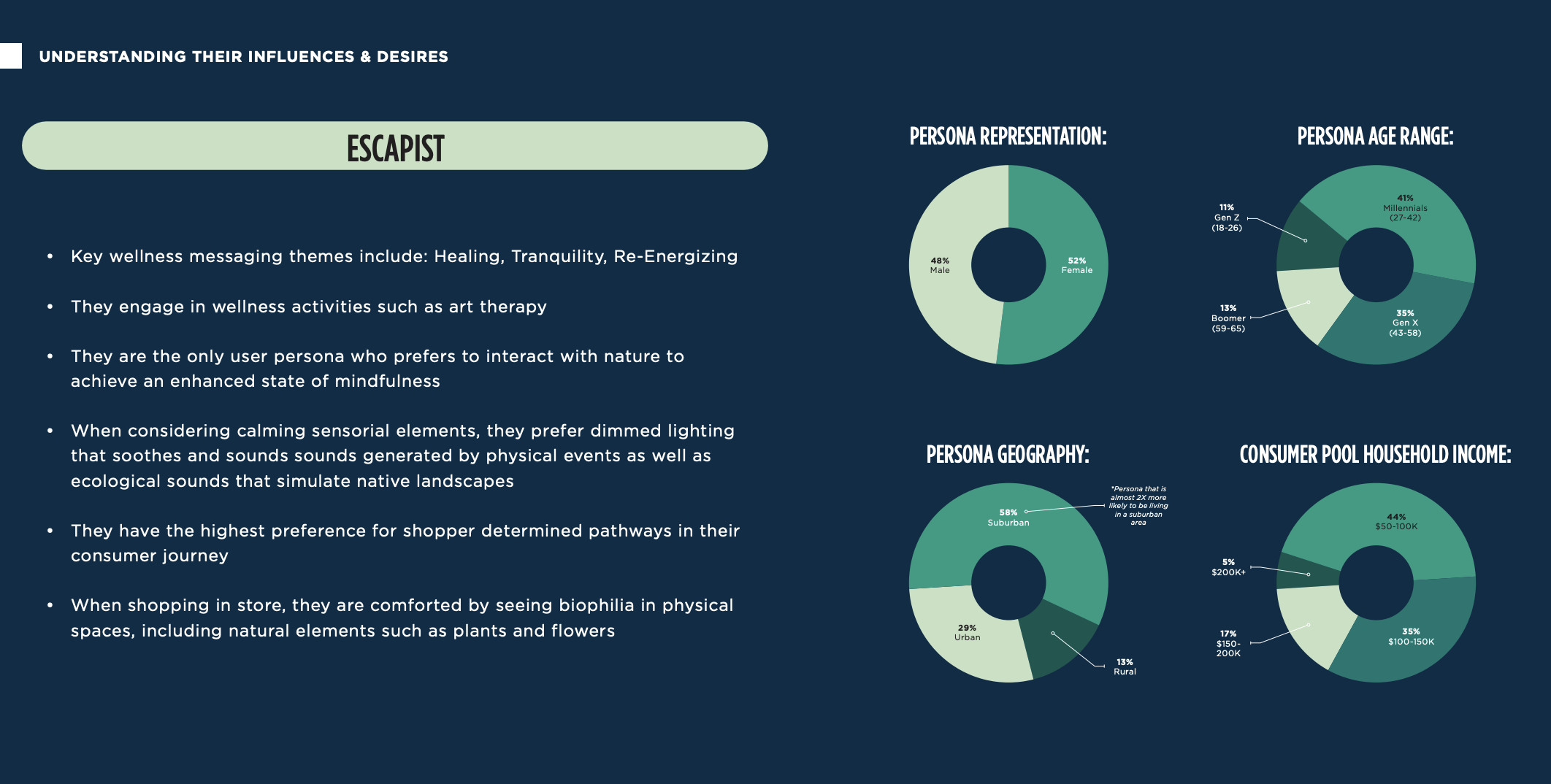

Knowledge about a product or service’s wellness characteristics and its effects on a consumer’s body and mind was deemed important information sought by the greatest percentage of respondents. It’s worth noting, too, that more than one-third of Generation Z consumers wants to know how a product will factor into their daily routines. “Brands and retailers have the ability to establish greater trust with their consumer audience by communicating these details, providing a deeper sense of confidence when deciding to invest in a product or service in support of their wellness journey,” the report states.
Sound, smell, and sight were identified by respondents as the three top integrated in-store senses for memorable experiences. And among the myriad “sensory scapes” that a shopping environment can present, sounds generated by physical events combined with natural light were the mostly likely to add a sense of calm for consumers, followed by ecological scenes and sounds that simulate native landscapes.
Synchronized music and lighting, on the other hand, ranked highest among the sensory scapes that would best add a sense of stimulation within consumers.
Lighting and tech can boost a retail store’s wellness ambience
“You can’t put a price tag on what delivers health and happiness,” says the report, which found that 85% of respondents differentiate wellness-driven retail experiences from conventional shopping.
For Ritualistics, what separates one from the other is how the experience enhances their daily lives. Escapists said it’s an experience that supports their emotional needs. And Pathfinders find wellness in shopping experiences that correspond with their everyday routines. (Boomers were the group least-inclined to see any difference between wellness-driven and traditional shopping.)
Lighting can be a significant factor in how consumers relate to a shopping environment. Nearly half of respondents to MG2’s survey said that dimmed lighting which soothes and provides a sense of leisure best contributes to a feeling of wellness, followed by lighting that mimics the patterns of natural light during the day. (Intriguingly, two out of five respondents with household incomes of $200,000 or more find bright light that energizes to be a contributing factor for wellness in stores.)
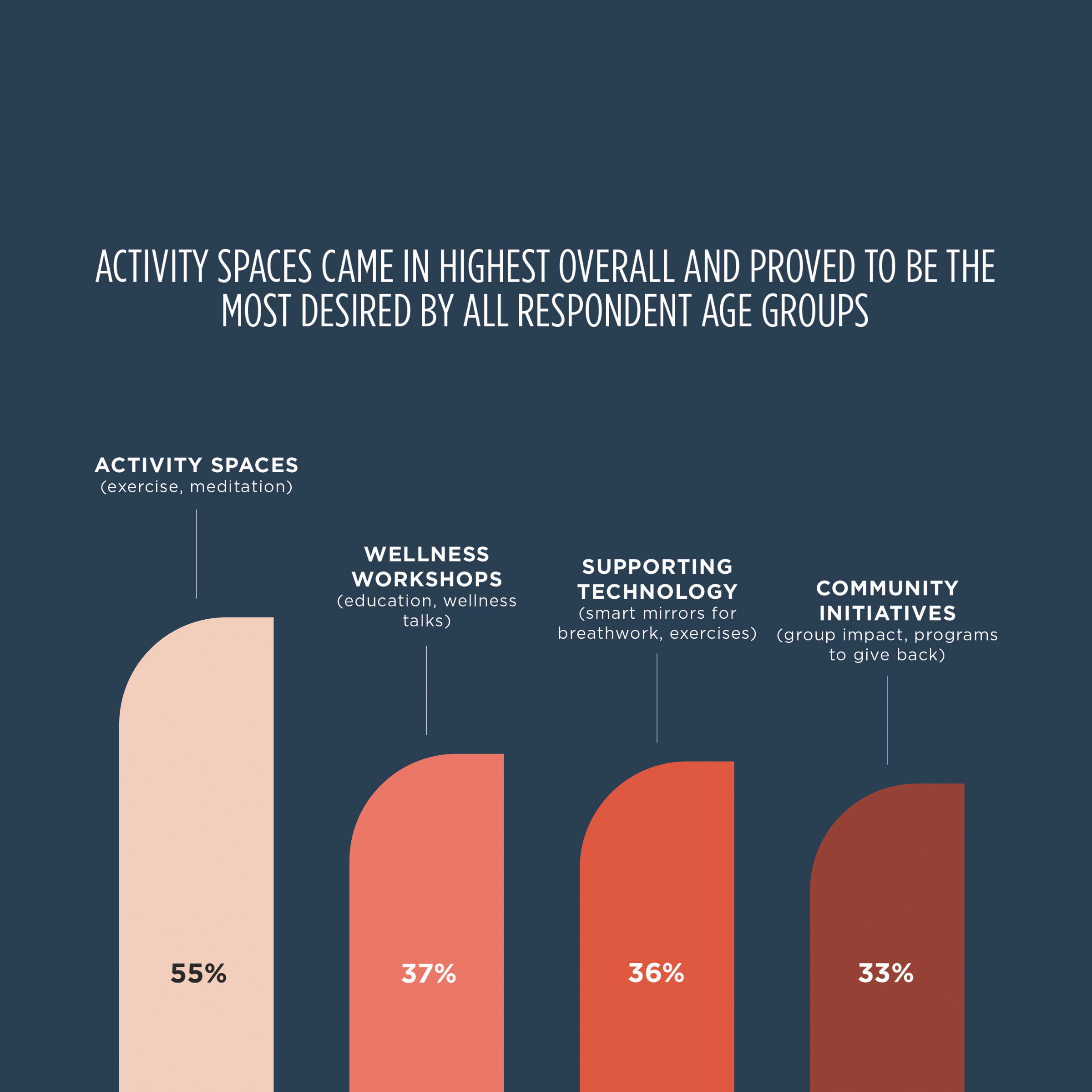
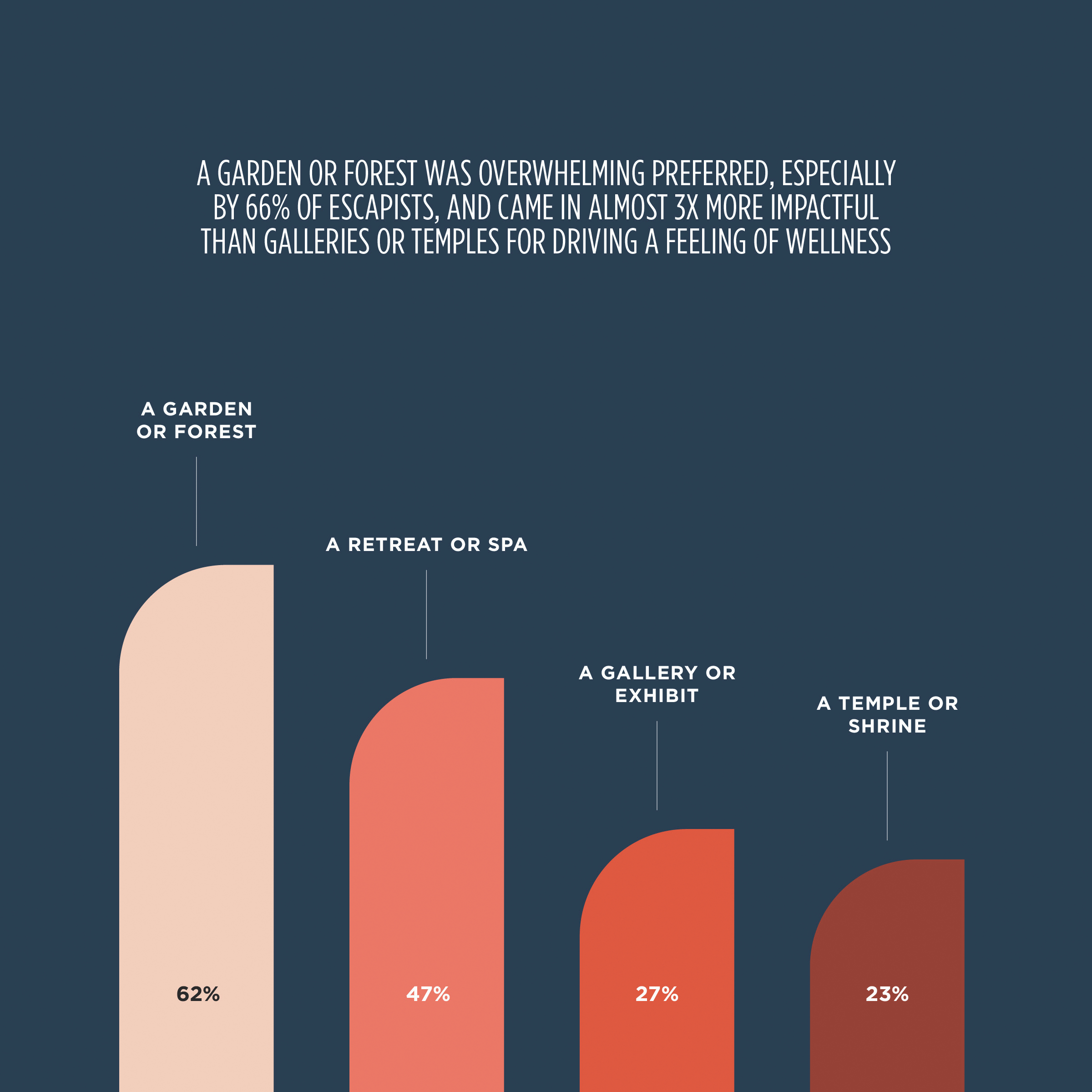
Fifty-five percent of respondents—and 66% of Boomers—cited activity spaces such as those carved out for meditation or exercise as the integrations they most desired in wellness-driven environments. A garden or forest was overwhelmingly preferred among aesthetics within shopping environments that would be most impactful in driving a feeling of wellness in consumers, followed by a retreat or spa.
MG2 posited that technology can be an “innovative and highly experiential” way to drive consumer education and engagement within the wellness space. More than one-third of Gen Z respondents thought that virtual reality can complement a wellness-driven consumer experience, while the highest percentage of Millennials and Gen X respondents (especially those who are female) singled out chromotherapy tech that uses light for physical and mental healing. Forty percent of Boomers saw wellness benefits in interactive wall and window displays that help them explore products and services.
Related Stories
Giants 400 | Sep 12, 2023
Top 80 Retail Sector Contractors and Construction Management Firms for 2023
Whiting-Turner, ARCO Construction, Swinerton, and PCL top BD+C's ranking of the nation's largest retail building contractors and construction management (CM) firms for 2023, as reported in the 2023 Giants 400 Report. Note: This ranking factors revenue for all retail buildings work, including big box stores, cineplexes, entertainment centers, malls, restaurants, strip centers, and theme parks.
Giants 400 | Sep 11, 2023
Top 140 Retail Sector Architecture and Architecture Engineering (AE) Firms for 2023
Gensler, Arcadis, Core States Group, WD Partners, and NORR top BD+C's ranking of the nation's largest retail sector architecture and architecture engineering (AE) firms for 2023, as reported in the 2023 Giants 400 Report. Note: This ranking factors revenue for all retail buildings work, including big box stores, cineplexes, entertainment centers, malls, restaurants, strip centers, and theme parks.
Adaptive Reuse | Aug 31, 2023
Small town takes over big box
GBBN associate Claire Shafer, AIA, breaks down the firm's recreational adaptive reuse project for a small Indiana town.
Giants 400 | Aug 22, 2023
Top 115 Architecture Engineering Firms for 2023
Stantec, HDR, Page, HOK, and Arcadis North America top the rankings of the nation's largest architecture engineering (AE) firms for nonresidential building and multifamily housing work, as reported in Building Design+Construction's 2023 Giants 400 Report.
Giants 400 | Aug 22, 2023
2023 Giants 400 Report: Ranking the nation's largest architecture, engineering, and construction firms
A record 552 AEC firms submitted data for BD+C's 2023 Giants 400 Report. The final report includes 137 rankings across 25 building sectors and specialty categories.
Giants 400 | Aug 22, 2023
Top 175 Architecture Firms for 2023
Gensler, HKS, Perkins&Will, Corgan, and Perkins Eastman top the rankings of the nation's largest architecture firms for nonresidential building and multifamily housing work, as reported in Building Design+Construction's 2023 Giants 400 Report.
Shopping Centers | Aug 22, 2023
The mall of the future
There are three critical aspects of mall design that, through evolution, have proven to be instrumental in the staying power of a retail destination: parking, planning, and customer experience. This are crucial to the mall of the future.
Adaptive Reuse | Aug 17, 2023
How to design for adaptive reuse: Don’t reinvent the wheel
Gresham Smith demonstrates the opportunities of adaptive reuse, specifically reusing empty big-box retail and malls, many of which sit unused or underutilized across the country.
Sponsored | | Aug 15, 2023
The Data Benefits of Retail Keyless Entry
SALTO’s wireless access control system provides valuable data analytics for retail establishments
Office Buildings | Aug 10, 2023
Bjarke Ingels Group and Skanska to deliver 1550 on the Green, one of the most sustainable buildings in Texas
In downtown Houston, Skanska USA’s 1550 on the Green, a 28-story, 375,000-sf office tower, aims to be one of Texas’ most sustainable buildings. The $225 million project has deployed various sustainable building materials, such as less carbon-intensive cement, to target 60% reduced embodied carbon.


